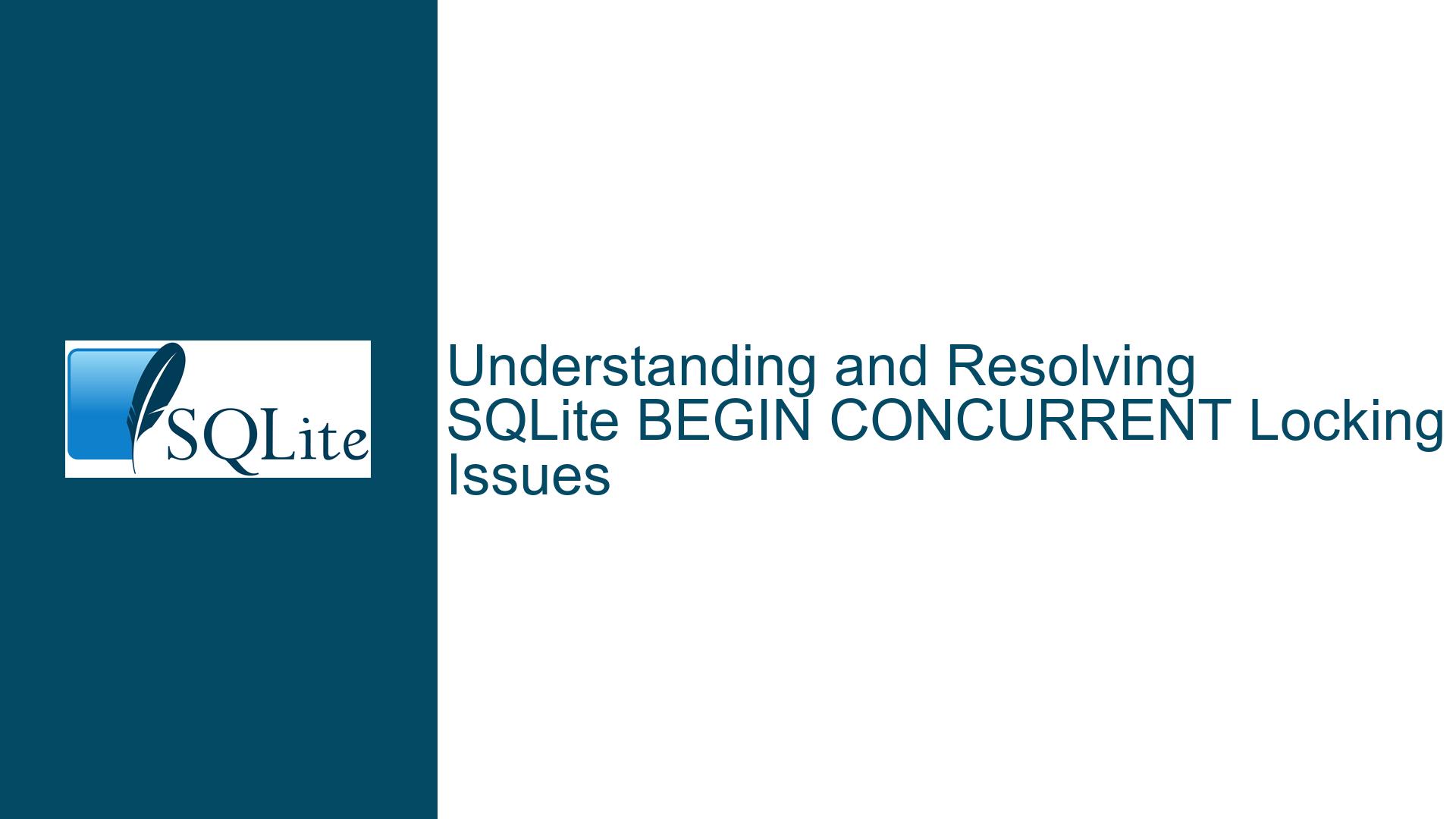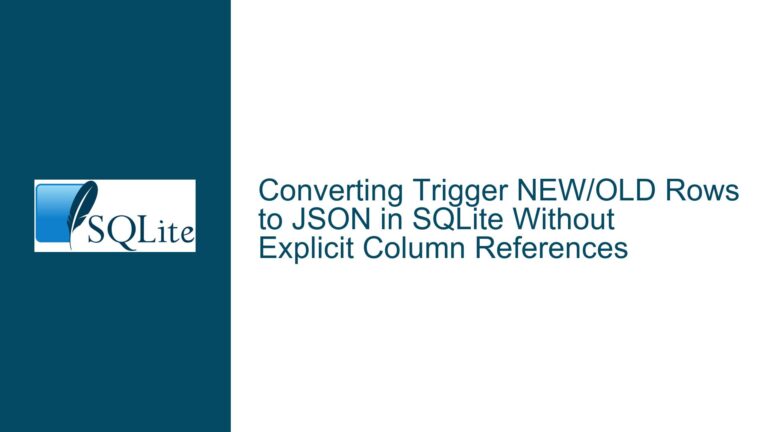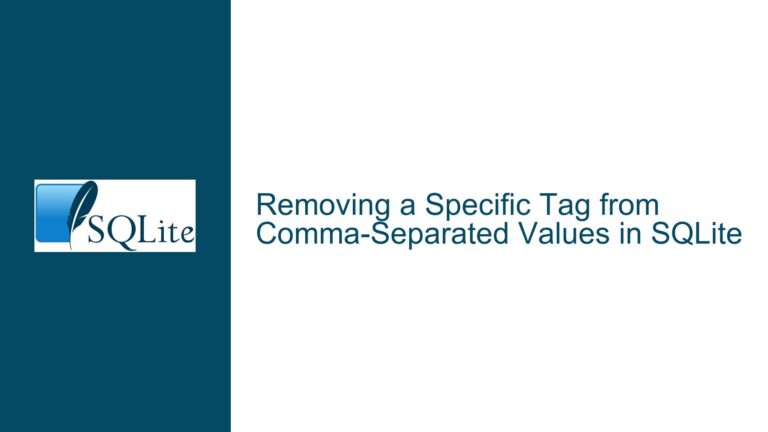and Resolving SQLite BEGIN CONCURRENT Locking Issues
Issue Overview: Concurrent Writes and Page-Level Conflicts in SQLite
SQLite is a lightweight, serverless database engine that is widely used for its simplicity and efficiency. However, when it comes to concurrent writes, SQLite has certain limitations that can lead to unexpected behavior, particularly when using the BEGIN CONCURRENT transaction mode. The core issue in this discussion revolves around the failure of concurrent transactions to commit successfully, resulting in a "database is locked" error. This problem is particularly pronounced when multiple transactions attempt to write to the same database page simultaneously.
The BEGIN CONCURRENT mode in SQLite is designed to allow multiple transactions to proceed concurrently, but it does not guarantee that all transactions will commit successfully. Instead, it employs a conflict resolution mechanism that checks for page-level conflicts at commit time. If a transaction detects that the pages it has modified have been altered by another transaction, it will fail with a "database is locked" error. This behavior is by design and is intended to maintain data integrity, but it can be confusing for developers who expect true concurrent writes without any conflicts.
In the scenario described, two terminals (T1 and T2) are used to initiate concurrent transactions. Both transactions attempt to insert data into the same table, which initially consists of a single page. Since both inserts target the same page, a conflict arises when the first transaction commits, causing the second transaction to fail. This behavior is consistent with SQLite’s page-level conflict resolution mechanism, but it raises questions about the practical utility of BEGIN CONCURRENT for certain use cases, such as append-only multi-insertion scenarios.
Possible Causes: Page-Level Conflicts and Transaction Isolation
The primary cause of the "database is locked" error in this scenario is the inherent limitation of SQLite’s concurrency model, which is based on page-level conflict resolution. When a transaction begins, it takes a snapshot of the database pages it intends to modify. If another transaction modifies any of these pages before the first transaction commits, the first transaction will detect a conflict and fail. This mechanism ensures that transactions are isolated from each other, but it also means that concurrent writes to the same page are inherently conflicting.
In the case of an empty table, all inserts will initially target the same page, leading to inevitable conflicts when multiple transactions attempt to insert data concurrently. This is because SQLite uses a B-tree structure to organize data, and a new B-tree starts with a single page. As more data is inserted, the page may eventually split, allowing for more concurrent writes. However, until the page splits, all inserts will target the same page, leading to conflicts.
Another factor contributing to the issue is the use of the WAL (Write-Ahead Logging) journal mode. While WAL mode improves concurrency by allowing readers and writers to operate simultaneously, it does not eliminate page-level conflicts. In fact, WAL mode can exacerbate the issue by allowing multiple transactions to proceed concurrently, only to fail at commit time when conflicts are detected. The discussion also mentions WAL2 and WAL3, which are experimental extensions of the WAL mode. However, these extensions do not fundamentally change the conflict resolution mechanism and are unlikely to resolve the issue.
Finally, the issue may be compounded by the lack of a queuing mechanism for concurrent writes. In a multi-threaded or multi-process environment, it is often necessary to serialize writes to avoid conflicts. SQLite does not provide a built-in queuing mechanism for concurrent transactions, which means that developers must implement their own solution, such as using a busy_timeout to retry failed transactions.
Troubleshooting Steps, Solutions & Fixes: Strategies for Handling Concurrent Writes in SQLite
To address the issue of concurrent writes and page-level conflicts in SQLite, several strategies can be employed. These strategies range from modifying the database schema to implementing custom conflict resolution mechanisms. Below, we explore these strategies in detail, providing practical solutions for developers facing similar issues.
1. Modify the Database Schema to Reduce Page-Level Conflicts
One of the most effective ways to reduce page-level conflicts is to modify the database schema to distribute writes across multiple pages. This can be achieved by creating multiple tables or by partitioning data within a single table. For example, instead of inserting all records into a single table, you could create separate tables for different categories of data. This approach ensures that concurrent writes target different pages, reducing the likelihood of conflicts.
In the scenario described, the tags table could be partitioned based on a specific criterion, such as the first letter of the name column. This would distribute inserts across multiple pages, allowing for more concurrent writes. However, this approach requires careful planning and may not be suitable for all use cases.
Another option is to use a composite primary key that includes a unique identifier for each transaction. This ensures that each insert targets a different row, reducing the likelihood of page-level conflicts. However, this approach may increase the complexity of the schema and require additional indexing.
2. Use a Busy Timeout to Retry Failed Transactions
Another strategy for handling concurrent writes is to use a busy_timeout to retry failed transactions. The busy_timeout pragma sets a timeout period during which SQLite will retry a transaction if it encounters a "database is locked" error. This approach effectively serializes writes, ensuring that only one transaction can proceed at a time.
In the scenario described, setting a busy_timeout would allow the second transaction to wait for the first transaction to complete before proceeding. This would prevent the "database is locked" error and ensure that both transactions commit successfully. However, this approach may increase the overall transaction time and reduce concurrency.
To implement this solution, you can set the busy_timeout pragma at the beginning of each transaction:
PRAGMA busy_timeout = 10000; -- Set a 10-second timeout
BEGIN CONCURRENT;
-- Perform inserts
COMMIT;
This approach is particularly useful in scenarios where conflicts are infrequent and the overhead of retrying transactions is acceptable.
3. Implement Custom Conflict Resolution Logic
In some cases, it may be necessary to implement custom conflict resolution logic to handle concurrent writes. This approach involves detecting conflicts at the application level and taking appropriate action, such as retrying the transaction or merging conflicting changes.
One way to implement custom conflict resolution is to use a versioning scheme for each row in the table. This involves adding a version column to the table and incrementing it with each update. When a transaction attempts to commit, it checks the version of each row it has modified. If the version has changed, the transaction knows that a conflict has occurred and can take appropriate action.
For example, you could modify the tags table to include a version column:
CREATE TABLE IF NOT EXISTS tags (
name TEXT PRIMARY KEY NOT NULL,
age INTEGER NOT NULL DEFAULT 0,
timestamp INTEGER NOT NULL DEFAULT 0,
version INTEGER NOT NULL DEFAULT 0
);
When inserting or updating a row, you would increment the version column:
INSERT INTO tags (name, age, timestamp, version) VALUES ('foo', 35, CURRENT_TIMESTAMP, 1);
During the commit phase, you would check the version of each row to detect conflicts:
BEGIN CONCURRENT;
-- Perform inserts
-- Check versions before committing
COMMIT;
This approach allows for more fine-grained conflict resolution and can be tailored to the specific requirements of your application.
4. Consider Alternative Database Engines for High-Concurrency Scenarios
While SQLite is a powerful and versatile database engine, it may not be the best choice for high-concurrency scenarios that require true concurrent writes. In such cases, it may be necessary to consider alternative database engines that offer more advanced concurrency control mechanisms.
For example, PostgreSQL supports true concurrent writes through its Multi-Version Concurrency Control (MVCC) mechanism, which allows multiple transactions to proceed without blocking each other. Similarly, MySQL and MariaDB offer various locking mechanisms that can be used to manage concurrent writes more effectively.
However, switching to a different database engine is a significant decision that should be made carefully, taking into account factors such as performance, scalability, and ease of use. In many cases, it may be possible to address the issue within SQLite by using one of the strategies described above.
5. Optimize the Use of WAL Mode
While WAL mode improves concurrency in SQLite, it is important to optimize its use to minimize conflicts. This involves understanding how WAL mode works and configuring it appropriately for your use case.
One key consideration is the size of the WAL file, which can impact performance and concurrency. The WAL file size is controlled by the wal_autocheckpoint pragma, which determines how often the WAL file is checkpointed (i.e., written back to the main database file). A smaller WAL file size can reduce the likelihood of conflicts, but it may also increase the frequency of checkpoints, which can impact performance.
To optimize the use of WAL mode, you can adjust the wal_autocheckpoint pragma:
PRAGMA wal_autocheckpoint = 1000; -- Set the checkpoint interval to 1000 pages
Additionally, you can manually checkpoint the WAL file using the wal_checkpoint pragma:
PRAGMA wal_checkpoint;
This approach allows you to control when the WAL file is checkpointed, reducing the likelihood of conflicts during high-concurrency periods.
6. Use Separate Database Files for High-Concurrency Workloads
In some cases, it may be beneficial to use separate database files for different parts of your application. This approach can reduce contention and improve concurrency by isolating high-concurrency workloads from other parts of the database.
For example, you could create a separate database file for logging or indexing, allowing concurrent writes to proceed without interfering with other operations. This approach requires careful management of database connections and may increase the complexity of your application, but it can be an effective way to handle high-concurrency scenarios.
To implement this solution, you would create a separate database file for each high-concurrency workload:
ATTACH DATABASE 'logs.db' AS logs;
You would then perform inserts into the separate database file:
INSERT INTO logs.tags (name, age, timestamp) VALUES ('foo', 35, CURRENT_TIMESTAMP);
This approach allows you to isolate high-concurrency workloads and reduce the likelihood of conflicts.
Conclusion
Concurrent writes in SQLite can be challenging due to the database’s page-level conflict resolution mechanism. However, by understanding the underlying causes of these conflicts and implementing appropriate strategies, it is possible to achieve a high degree of concurrency while maintaining data integrity. Whether through schema modifications, custom conflict resolution logic, or the use of alternative database engines, developers have a range of options for handling concurrent writes in SQLite. By carefully considering the specific requirements of your application and experimenting with different approaches, you can find the best solution for your needs.






